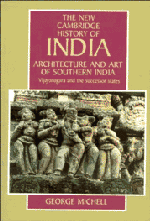4 - Temple architecture: the Tamil zone
Published online by Cambridge University Press: 28 March 2008
Summary
Religious foundations in the growing cities and popular pilgrimage sites of the Tamil country were repeatedly renovated and extended throughout the Vijayanagara and Nayaka periods. Temples were transformed into vast complexes, with multiple sanctuaries, subshrines, mandapas, corridors, courtyards, tanks and gopuras. These architectural components survive in a diversity of styles that encompass all of the centuries under investigation here. Disentangling the successive building phases is no easy task since there is rarely any simple coordination of chronology and overall layout. While it is true that religious monuments generally expanded outwards during this era, with the latest additions being located at the peripheries, much activity was directed towards replacing earlier structures at the core and filling in the open spaces in between.
The Rayas had a profound impact on temple building in the Tamil zone, but it is only with difficulty that their contribution can be estimated; this is because many Vijayanagara structures, especially those belonging to the Sangama period, are obscured by later and larger additions. Gopuras and free standing mandapas commissioned by the Nayakas are easier to distinguish, being larger and more conspicuous. Building construction seems to have reached a peak of activity towards the middle of the seventeenth century when temples attained their greatest extent and elaboration. Nowhere is this better seen than in the Minakshi-Sundareshvara complex, the greatest project of the Madurai Nayakas (Fig. 42). This overall trend towards increase in scale was frequently accompanied by a concern for planometric geometry: the most important religious complexes were laid out in regular sequences of enclosures, generally in concentric formation, to encompass vast areas.
- Type
- Chapter
- Information
- Architecture and Art of Southern IndiaVijayanagara and the Successor States 1350–1750, pp. 73 - 120Publisher: Cambridge University PressPrint publication year: 1995



